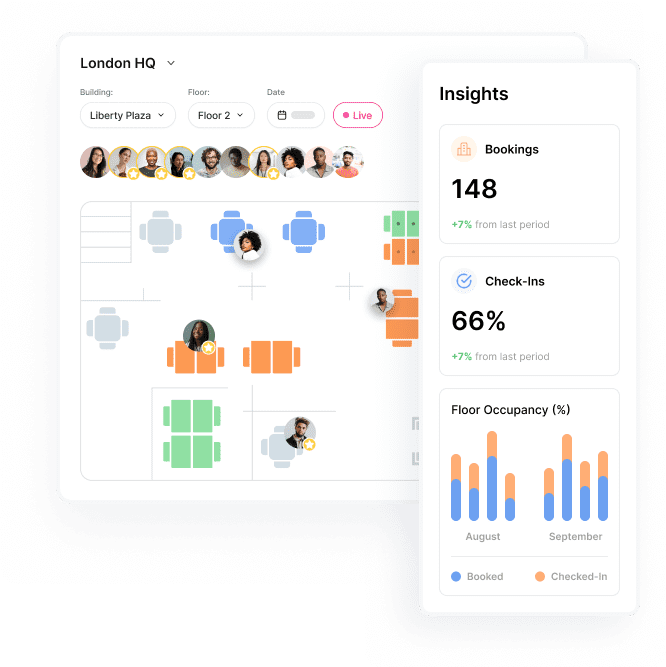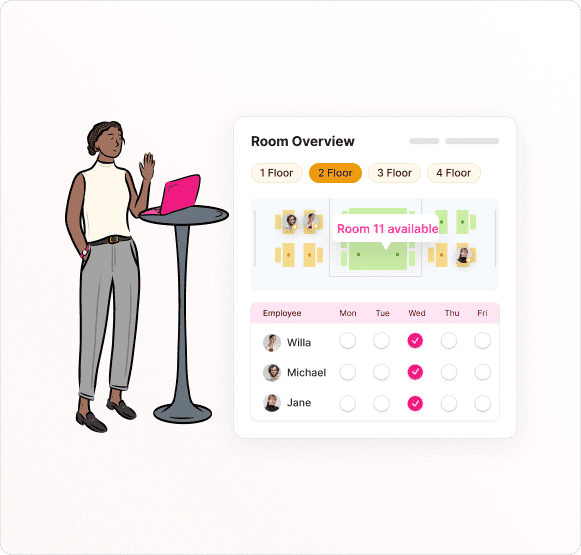The way we get work done in the professional world is changing dramatically.
If you’re a manager or employee at a higher education organization, you realize your sector is no different. As your workforce and spaces change, you are faced with a unique set of challenges in managing your spaces effectively under a hybrid system.
At the heart of these challenges lies the need to create an environment that is both functional and enjoyable for higher education employees. But how do you balance the demands of a modern workforce with the practicalities of space management?
In this article, we’ll dive into some of the common challenges your higher education organization may encounter in managing your space, and explore how space management software can help you get smarter about how you use physical spaces and desks — and ultimately solve your space utilization woes.
1. Downsizing Staff Offices
As your higher education organization evolves, there is a growing need to reconfigure traditional office layouts to create more collaborative and multipurpose spaces and save on real estate costs.
Downsizing staff offices and desk space to make room for other amenities like study areas, meeting rooms, and recreational facilities is becoming just as important as cutting down on unnecessary space altogether.
But getting a clear understanding of your higher education office space and managing this transition can be challenging without proper systems in place.
The Solution
To address this challenge, your higher education organization can implement a desk booking management tool. These tools help maintain discipline by requiring staff to book a desk before coming in, effectively managing who is in the office and when. Desk booking systems support the concept of desk hoteling, allowing staff to use shared spaces efficiently without the need for permanent individual offices. This approach allows higher education organizations to optimize on your space usage and make crucial decisions on where and how to downsize.
2. Understanding Space Usage
As well as the need to cut down on unused space, your higher education organization is also faced with understanding exactly how your existing space is being used.
University offices might have certain areas or meeting rooms that are rarely used, while other parts of the administrative buildings are constantly overcrowded. This uneven distribution can lead to wasted resources and frustration among your higher education employees, who may find it difficult to access the spaces they need when they need them.
Underutilized spaces often stem from a lack of proper scheduling and planning. For instance, large conference rooms might be booked for small meetings, leaving smaller, more suitable rooms empty. Additionally, areas designated for specific purposes, like archives or IT rooms, may not be repurposed for other activities when not in use. This inefficiency not only impacts the physical space but also affects the overall energy consumption and maintenance costs of your higher education office in question.
The Solution
The right space management tools will come equipped with data and analytics that provide valuable insights into space utilization patterns. By looking at a breakdown of how different spaces are used throughout the day, week, or semester, your higher education office managers or administrators can identify patterns in space utilization and make informed decisions that benefit everyone involved. That could mean “switching off” certain areas when not in use to save on energy bills or grouping desks in different spaces to distribute higher education employees more efficiently.

3. Seamless Scheduling and Booking
We’ve all had them. There’s nothing more frustrating than turning up to your workplace only to find someone has already occupied your favorite desk or work area. Even after you highlighted the right cell on your shared Google sheet!
Scheduling conflicts often come about due to the complexity of organizing people and their movements. That Google sheet gets confusing (fast!) and helps precisely no one understand which spaces are available and which are not. Desks in higher education offices might be frequently double-booked, or a conference room might be reserved on multiple days but never actually used.
Booking conflicts can lead to last-minute changes, cancellations, and a general sense of frustration among employees.
The Solution
Space management tools are built with the main goal of organizing people and spaces. That means they come with scheduling software that helps the people within a higher education organization see, at a glance, when and where there are available workspaces. By integrating a centralized scheduling platform, your higher education organization can streamline the booking process, making it easier for everyone to find and reserve the spaces they need without running into conflicts. A top tier space management solution will also come with AI-driven Smart Suggestions — automated prompts that help avoid scheduling conflicts and suggest bookings that make sense for each individual.
4. Fast Integration and Intuitive UX
Integrating new technologies with existing systems might seem like a daunting task for your higher education organization. Your current infrastructure may be complex and include a variety of legacy systems and software that are not easily compatible with modern solutions.
For example, you might have have separate systems for room bookings, resource management, and user access, all of which need to be synchronized to function effectively. This lack of integration can lead to inefficiencies, data silos, and — ultimately — a lot of headaches.
To add to your troubles, the rapid pace of technological advancement means that your higher education organization is always under pressure to keep up with new developments. This ongoing need for updates can be resource-intensive and disruptive if not managed properly. The result is often a patchwork of solutions that do not communicate well with each other, and only end up complicating the task of space management.
The Solution
Simplify! Space management tools are there to help you reduce complexity, not add to it. By integrating a platform that offers seamless management of room bookings, resource allocation, and user access from a single interface — you’ll find your higher education organization relies on fewer tools to achieve greater results. Furthermore, the right space management tool should be easy to integrate into your existing tech stack — an out-of-the-box solution that integrates with Microsoft Teams, Google Workspace or Workday — and come with a UX that is easy and intuitive to navigate as a first-time user.

5. Robust Security and Privacy
In an era where data breaches and privacy concerns are increasingly prevalent, ensuring the security and privacy of your higher education organization and employees is another major challenge.
Your higher education organization is most likely under pressure to protect sensitive personal data related to your employees, as well as information relating to the campus and facilities in general.
Without robust security measures, your systems are vulnerable to unauthorized access, data breaches, and other security threats, which can compromise the integrity of the organization and the safety of your community.
The Solution
Look out for space management software that comes with next-gen security infrastructure and measures. Your chosen platform should be SOC 2 compliant, maintain Cyber Essentials certification and data should be encrypted both in-transit and at rest. Making sure you partner with a space management tool that upholds the highest data and privacy standards will give you peace of mind when it comes to integrating a new tool into your university workflow.
Manage Your Spaces with Kadence
Effective space management is essential for creating a productive and enjoyable environment for higher education organizations.
Whether you’re dealing with unused spaces, scheduling conflicts, technology integration, or ensuring security and privacy, Kadence offers comprehensive solutions tailored to meet your unique challenges.
Our platform leverages data analytics, flexible scheduling, integrated technological infrastructure, and robust security measures to optimize your office spaces.
Trust Kadence to provide the tools you need to create a seamless, efficient, and secure environment for your employees.

